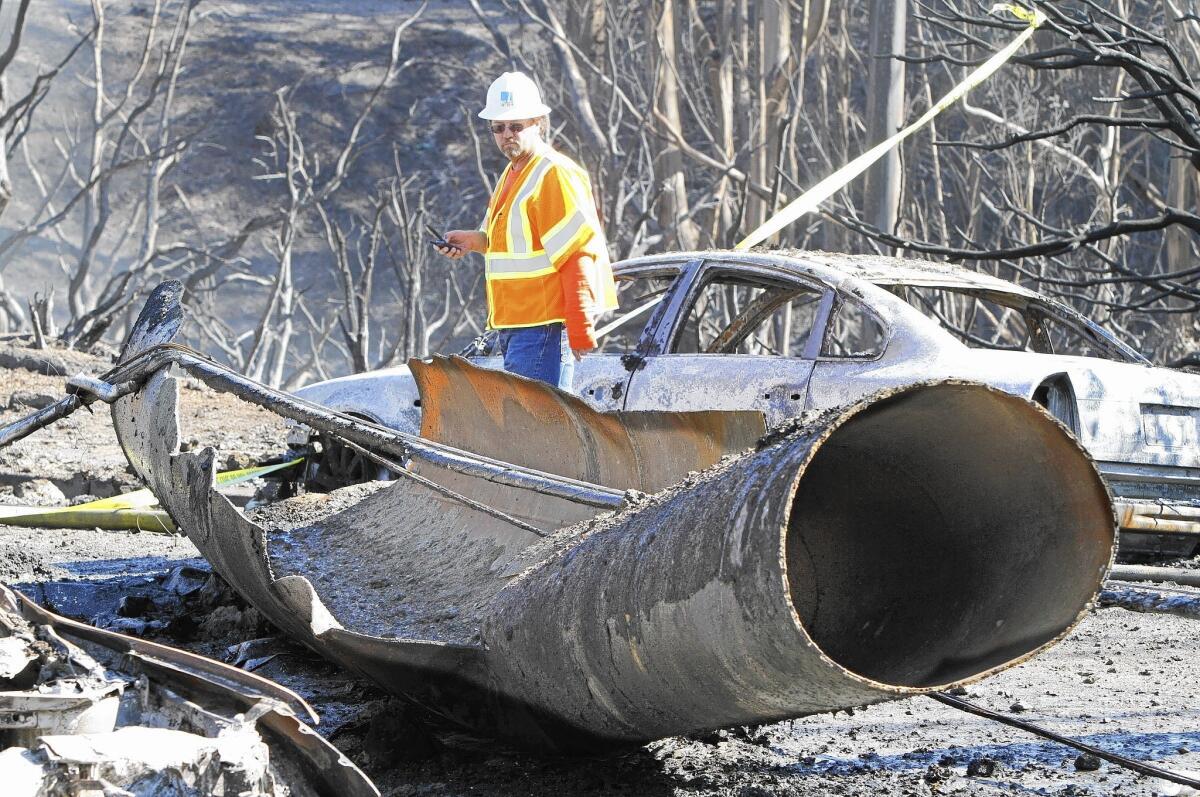PUC proposes $1.4-billion PG&E fine for San Bruno explosion

- Share via
REPORTING FROM SACRAMENTO — California’s largest utility, Pacific Gas & Electric Co., should pay $1.4 billion for a 2010 pipeline explosion that leveled a Bay Area neighborhood and killed eight people, state regulators proposed Tuesday.
The penalty, which is not yet final, would be the biggest safety-related fine in the history of the California Public Utilities Commission. The fine would be paid by San Francisco-based PG&E shareholders and not its customers, who live from the Oregon border to Bakersfield.
Two administrative law judges at the California Public Utilities Commission on Tuesday issued their decisions based on 3,798 alleged violations of state and federal laws and regulations that govern gas pipeline safety and operations.
In addition to the deaths, the Sept. 9, 2010, explosion and firestorm in San Bruno, near San Francisco International Airport, destroyed 38 houses and injured 66 people. Federal investigators concluded that the blast — which left a 167-foot crater in the street — was caused by defective welds in the 54-year-old, 30-inch-diameter pipe.
The proposed penalty far exceeds the previous record of $38 million, also against PG&E, for a fatal December 2008 explosion in the Sacramento suburb of Rancho Cordova. But it’s less than the $2.25 billion proposed by PUC staff, even when combined with the $635 million PG&E has been credited for post-explosion safety expenses.
“I think they are getting off somewhat easy,” said State Sen. Jerry Hill (D-San Mateo), who represents San Bruno. “They should not be getting credit.”
In addition to the fine, the company still faces 27 federal criminal charges related to allegations it lied to federal investigators and misled U.S. transportation officials probing the blast.
The National Transportation Safety Board, which investigated the explosion, lambasted PG&E for a “litany of failures” and inadequate inspections and record keeping. For example, it took the company nearly 95 minutes to shut off the gas that spewed from the broken pipeline. The NTSB also faulted state and federal regulators, including the PUC, for lax oversight of the utility.
PG&E declined to say whether it planned to appeal the proposed fine.
“We are accountable and fully accept that a penalty is appropriate,” the company said in a statement. “We have respectfully asked that the commission ensure that the penalty is reasonable and proportionate and takes into consideration the company’s investments and actions to promote safety.”
PG&E stressed that it has spent billions of dollars on safety improvements, including additional pipeline testing and inspection, upgraded valves and better records management.
San Bruno officials said that they were generally satisfied with the proposed fine and that it would take money out of the pockets of corporate shareholders, not PG&E’s 15 million customers.
“It’s a strong decision and poses a significant financial consequence on PG&E,” said Connie Jackson, San Bruno’s city manager.
The Utility Reform Network, which represents ratepayers at the San Francisco-based commission, called the $1.4 billion “significant” and proof of what a “huge public outcry can accomplish.”
But the city and ratepayer group criticized the judge’s call for PG&E to pay $950 million to the state’s general treasury and dedicate the balance of $450 million to upgrading the gas distribution network.
“We don’t see that fine contributing directly to pipeline safety improvement, which we consider critically necessary,” Jackson said.
Much work is still needed on PG&E’s system, which had been plagued by delayed maintenance and faulty record keeping, the city contends.
San Bruno Mayor Jim Ruane called on Gov. Jerry Brown to reinvest the nearly $1 billion in more gas pipeline safety work. He also demanded that PG&E “do the right thing and respect the penalty without appeal.” After all, he said, “an entire neighborhood was blown apart.”
Ratepayer advocates and other interested parties, including the city, can submit formal comments within 30 days. The judge will review those comments — and a PG&E appeal, if one is filed — to determine whether to revise the $1.4-billion fine. The five-member commission, all appointed by the governor, will vote on the final penalty in public session, probably early next year.
Twitter: @MarcLifsher
More to Read
Inside the business of entertainment
The Wide Shot brings you news, analysis and insights on everything from streaming wars to production — and what it all means for the future.
You may occasionally receive promotional content from the Los Angeles Times.











